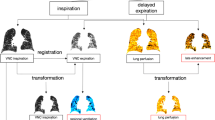Abstract
The purpose of this study was to detect disturbances in pulmonary circulation in collagen disease patients by means of a non-invasive technique.Methods: Ventilation/perfusion scans with133Xe gas and99mTc-macroaggregated albumin (MAA) were performed in 109 patients with various collagen diseases. Functional images of V, Vol, Q and V/Q ratio were obtained at total lung capacity. Wash-out time was calculated from the wash-out curve. Whole body scans were performed in 65 patients to evaluate intra-pulmonary shunts.Results: Increased V/Q areas were observed in 74 patients (67.9%), suggesting some impairment of pulmonary perfusion. Decreased perfusion, probably due to vasculitis or intravascular microcoagulation, was observed often, even in patients without pulmonary fibrosis. Shunt ratios over 10% were observed in 8 of the 65 patients (12.3%), indicating formation of PA-PV shunts secondary to peripheral vascular impairment. Wash-out time was prolonged in 37 patients (33.9%), shortened in 18 (16.5%), and within the normal range in 54 (49.6%). The prolonged and normal wash-out times in the patients with pulmonary fibrosis may represent obstructive changes in the small airways superimposed on the fibrosis.Conclusion: Ventilation/perfusion scans are a very useful tool for evaluating collagen lung diseases, and they might contribute to treatment decisions for the patients.
Similar content being viewed by others
References
Boulware DW, Weissman DN, Doll NJ. Pulmonary manifestations of the rheumatic diseases.Clin Rev Allergy 3: 249–267, 1985.
Takizawa H, Suzuki N, Yanagawa T, Okazaki H, Satoh M, Akiyama N, et al. Pulmonary involvement of collagen vascular diseases: studies on prognostic factors from basic and clinical viewpoints (Japanese).Nihon Kyoubu Shikkann Gakkai Zasshi 33 (Suppl): 291–295, 1995.
Wolfe JD, Tashkin DP, Holly FE, Brachman MB, Genovesi MG. Hypoxemia of cirrhosis: detection of abnormal small pulmonary vascular channels by a quantitative radionuclide method.Am J Med 63: 746–754, 1977.
Kosuda S, Shioyama Y, Kamata N, Akita S, Mezaki T, Suzuki K, et al. Usefulness of ventilation and perfusion scans in patients with collagen-vascular diseases (Japanese).KAKU IGAKU (Jpn J Nucl Med) 27: 841–844, 1990.
Grob JJ, Bronerendi JJ. Antiphospholipid antibodies: new data in the pathogenesis of collagenosis.Ann Dermatol Venereol 113: 811–818, 1986.
Crausman RS, Achenbach GA, Pluss WT, O'Brien RF, Jennings CA. Pulmonary capillaritis and alveolar hemorrhage associated with the antiphospholipid antibody syndrome.J Rheumatol 22: 554–556, 1995.
Rich S. Primary pulmonary hypertension: recent advances.Herz 11: 197–206, 1986.
Ueki J, Hughes JM, Peters AM, Bellingan GJ, Mohammed MA, Dutton J, et al. Oxygen and99mTc-MAA shunt estimation in patients with pulmonary arteriovenous malformations: effects of changes in posture and lung volume.Thorax 49: 327–331, 1944.
Schrijen F, Jezek V. Haemodynamics and pulmonary wedge angiography findings in chronic bronchopulmonary diseases.Scand J Resp Dis 58: 151–158, 1977.
Bowen JS, Bookstein JJ, Johnson AD, Peterson KL, Moser KM. Wedge and subselective pulmonary angiography in pulmonary hypertension secondary to venous obstruction.Radiology 155: 599–603, 1985.
Baron M, Feiglin D, Hyland R, Urowitz MB, Shiff B. Gallium-67 lung scans in progressive systemic sclerosis.Arthritis Rheum 25: 969–974, 1983.
Coates G, O'Brodvich HM. Pulmonary clearance of99mTc DTPA: a noninvasive assessment of epithelial integrity.Lung 165: 1–16, 1987.
Lu G, Shih WJ, Chou C, Xu JY. Tc-99m MAA total-body imaging to detect intrapulmonary right-to-left shunts and to evaluate the therapeutic effect in pulmonary arteriovenous shunts.Clin Nucl Med 21: 197–202, 1996.
Whiyte MK, Hughes JM, Peter AM, Ussov W, Patel S, Burroughs AK, et al. Analysis of intrapulmonary right to left shunt in the hepatopulmonary syndrome.J Hepatol 29: 85–93, 1998.
Lange PA, Stoller JK. The hepatopulmonary syndrome.Ann Intern Med 122: 521–529, 1995.
Feigin DS. Vasculitis in the lung.J Thorac Imaging 3: 33–48, 1988.
Henrisken O, Lønborg-Jensen H, Rasmussen FV. Evaluation of a method for determination of mean transit time of Xenon-133 in the lungs.J Nucl Med 21: 333–341, 1980.
Lowe VF, Sostman HD. Pulmonary embolism.In Nuclear Medicine in Clinical Diagnosis and Treatment, Murray IPC, Ell PJ (eds.), 2nd ed., London, Churchill Livingstone, Inc., pp. 37–54, 1998.
Author information
Authors and Affiliations
Corresponding author
Rights and permissions
About this article
Cite this article
Suzuki, K., Kamata, N., Inokuma, S. et al. Clinical significance of ventilation/perfusion scans in collagen disease patients. Ann Nucl Med 14, 405–413 (2000). https://doi.org/10.1007/BF02988285
Received:
Accepted:
Issue Date:
DOI: https://doi.org/10.1007/BF02988285




